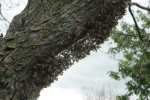Walnut caterpillars strip pecan, other trees of leaves

Walnut caterpillars have devastated most of what was left of this year's pecan and walnut crops in Vernon County, devouring all the leaves from the trees in a matter of just a few days.
Local pecan producers were not expecting a good harvest this year -- groves had already been traumatized by a late spring freeze that had diminished the crop by as much as 95 percent, Kimmell said. Then came the flooding. Pecans grow well in bottom land that's prone to flooding, according to Kansas State University, but high waters were a trial for producers, nevertheless. But a third scourge of fuzzy, unattractive caterpillars has done in most of the scant harvest and left trees as bare as one might expect them to be in winter.
Drew Kimmell of Missouri Northern Pecan Growers said local groves were stripped clean of all the leaves in a matter of about three days. "This morning I heard that they're everywhere from Adrian to Tulsa. They're flat steppin' out. I haven't seen anything like this," Kimmell said.
Vernon County University of Missouri Extension Agronomy Specialist Pat Miller agreed.
"We have some every year but not in these numbers. They are really bad, at least from Lamar to Adrian," Miller said in an e-mail.
A Compton Junction resident reported that a tree in the yard had been literally covered with the creatures, which ate the tree bare of leaves. Nearby, at Wilson's Pecan Farm, Florence Wilson reported that she had been out of town when she got a call from workers who told her that the trees had been eaten to a completely barren state in two days.
She was skeptical -- until she saw the groves for herself. By Thursday, only a few of the caterpillars, which evolve into brown moths, remained.
"They don't seem to have a very long life span, but they sure are hungry when they're here. These trees were completely covered with them," Wilson commented.
Walnut caterpillers are picky eaters. The larvae feed only on certain types of trees -- black and English walnut, pecan, butternut and some species of hickory. They appear on other surfaces like walls, bushes, weeds, grasses and other tree species, but the USDA says no feeding occurs in these places.
The greatest amount of feeding usually occurs in August. Although tree growth and vigor are reduced by these infestations, epidemics have seldom lasted longer than two years, the USDA said.
Miller said, "A one-time defoliation shouldn't kill a healthy tree," but noted there was severe drought last year and a late freeze this year, which may have left some of the trees in less than optimum shape.
There are two generations per year in this part of the country. After feeding, they gather in a large group on branch where they molt, leaving behind a mass of skins. Then, they usually drop to the ground and burrow into the ground where they transform into moths, rather than spinning a cocoon.
The walnut caterpillar has several natural predators, including certain types of flies, wasps and beetles. Mice also consume the pupae.
Kimmel said that some have chosen to spray pesticides to alleveiate the problem -- which, he said, works -- but many chose not to, because given the fact that little production was expected, doing so may not be cost effective.
He also said only time will tell what impact this year's infestation of walnut worms will have on next year's crop.
Looking at the barren trees, Wilson said they'll set their sights on next year, hoping for the best.
"It's been a tough year for pecan growers," Kimmel said.
